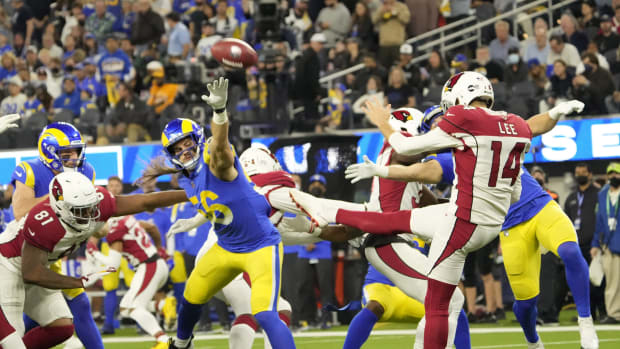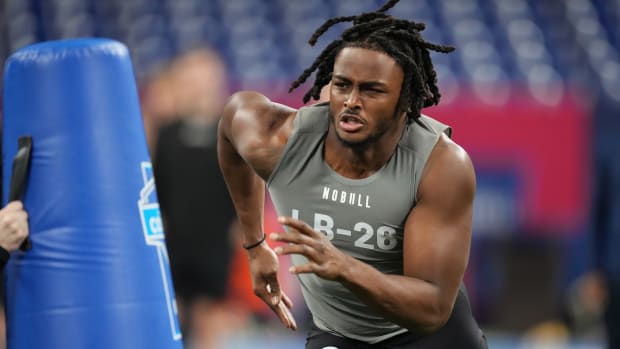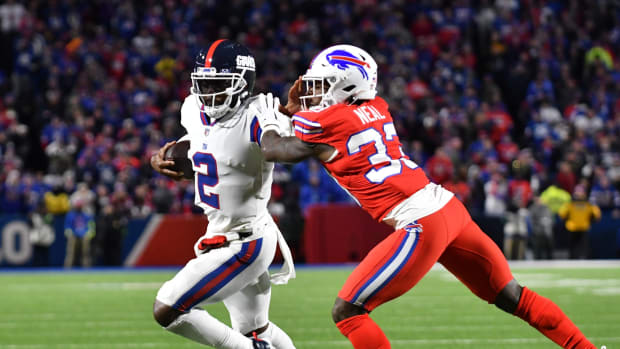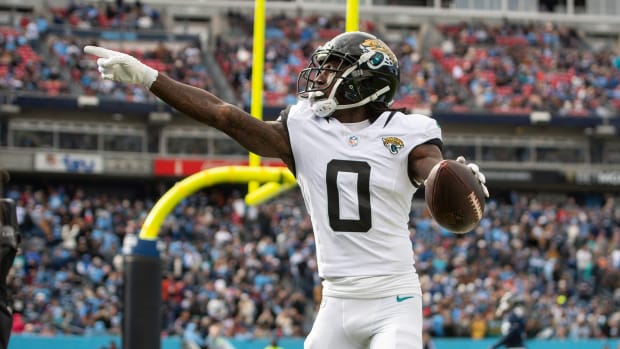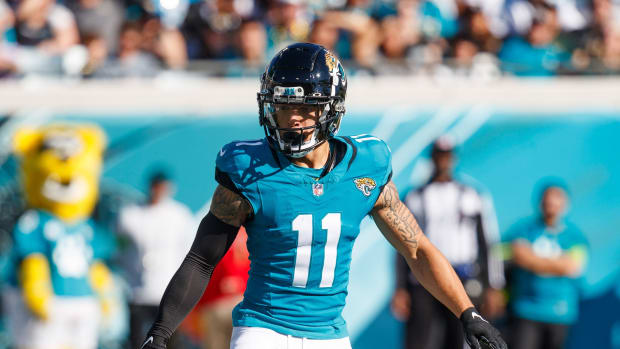The Roughing the Passer Rule and Football’s Unfixable Problem
This story appears in the Oct. 8 issue of Sports Illustrated. To subscribe, click here.
For at least a decade, and in some ways much longer than that, the National Football League has been trying to thread the eye of a tiny sewing needle with a thick strand of barbed wire. A sport once left unchecked to grow its own mythology through 16-millimeter homages to manliness has found itself under fire from a force of activists, researchers, media, even its own former players, all demanding that the game be made safe. It is, by consensus, both a reasonable and wholly unachievable mandate. “I mean, it’s football,” says backup Bears quarterback Chase Daniel, a nine-year NFL veteran. “You are playing a violent sport.” Bodies collide at high speed, in real time, with large sums of money in play; safety is an inconvenience. Nevertheless, that is the charge.
The tension between the NFL and bodily preservation goes back decades, to an era when football players were only somewhat bigger, faster and stronger than normal men—before the outsized humans who play the game today, flesh-and-blood cyborgs created by multiple generations of weight and speed training, nutrition and, in some cases, chemical enhancement (not just for success, but also for survival). The more meager size and potency of those old-school athletes was offset by devastating tactics: clothesline tackles, knee-level crackback blocks, head slaps—with a defender smacking a massive mitt against the thin plastic wall of his blocker’s helmet. Imagine the concussions.
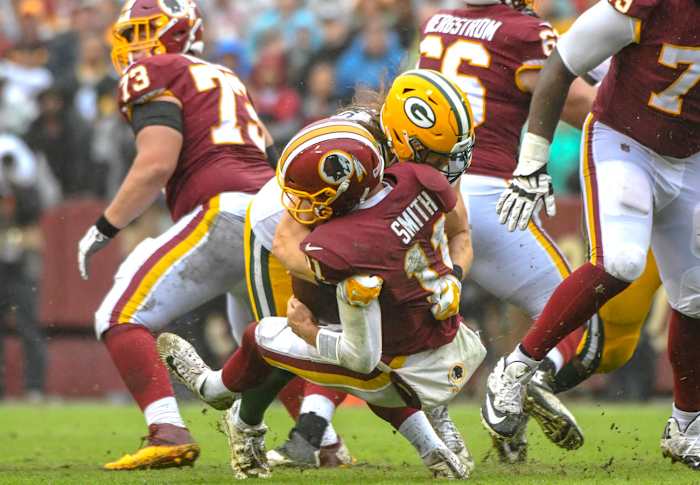
In Week 3, Matthews was flagged for a hit on Smith that would have been textbook in any previous season.
Mark Goldman/Icon Sportswire via Getty Images
Yes, all of these methods were eventually deemed illegal (the head slap wasn’t outlawed until 1977, three years after the retirement of its chief practitioner, Hall of Famer Deacon Jones), but these were obligatory tweaks to obviously barbaric and dangerous practices that only marginally altered the game.
In the late 2000s, such tweaks became insufficient. A confluence of research, outrage and the visceral imagery of strong men being repeatedly rag-dolled and carted off, dazed or unconscious, changed the direction of the sport. Former players were discovered to have been living—and dying—in extraordinary pain. Science came forward with studies showing a connection between head blows and brain damage; fans learned about (and some learned to hate) chronic traumatic encephalopathy, or CTE. Faced with an existential threat, the NFL, and eventually all levels of football, instituted rules configured to salvage both its players and its business. (Or its business and its players. The priority is up for interpretation.) A new vocabulary was introduced. Receivers became defenseless. Tacklers were described as finding their aiming point. Brutal hits, once such a part of the culture that ESPN devoted a popular weekly segment to them called “Jacked Up,” became taboo, an indulgence that fans embraced like teenagers illicitly vaping in the school parking lot. It was no longer socially acceptable to publicly support the blood lust.
• THE MMQB NFL PODCAST: Four episodes each week, from Andy Benoit, Gary Gramling, Albert Breer, Jenny Vrentas, Conor Orr and the rest of The MMQB crew. Subscribe on iTunes to get it in your inbox.
Make no mistake, the game has changed. Panthers coach Ron Rivera was a backup linebacker on the historic 1985 Bears defense, and he says that in the current atmosphere “guys like [Chicago linebackers] Otis Wilson and Wilber Marshall would be in trouble. [Defensive tackle] Dan Hampton would be in trouble.” Rivera references the notorious helmet-to-chin blow Marshall laid on Lions quarterback Joe Ferguson that season, a vicious kill shot that a modern NFL fan might find as obsolete as a leather helmet. Marshall wasn’t penalized or suspended for that hit, but he was fined $2,000. Mike Ditka, the Bears’ coach, said at the time, “If that’s not good football, then we should get skirts on and do something else.” Marshall added, “I didn’t think I hit him that hard.” So, yeah. Football has changed.
And it’s not necessary to go back three decades to trace the evolution. The trigger for many recent changes was the so-called “Bloody Sunday” of Oct. 17, 2010, when a series of big hits propelled the safety discussion forward by years, all at once. Steelers linebacker James Harrison’s head shot on the Browns’ Mohamed Massaquoi, on a shallow cross? That kind of hit has been completely legislated out of the game.
The evolution is ongoing, but now it seems to have reached a tipping point, with fans and players alike throwing up their arms in the universal symbol for I Give Up! At issue is change to an 80-year-old rules infraction, which has abruptly been dusted off and magnified at the behest of the NFL rules committee. Simple enough. But this has become the hill on which a form of traditional football seems destined to slowly die, as safety meets business and the only real means of keeping players healthy and coffers brimming is the continued emphasis on the forward pass.
On Sept. 30, Bears quarterback Mitch Trubisky threw six touchdown passes in a win over the Buccaneers. Two weeks earlier, the Chiefs’ Patrick Mahomes also put up six. According to Pro Football Reference, only 40 times in NFL history has a QB thrown six or more TD passes in a single game—and it happened twice in the first four weeks of the season (by two guys with a combined 20 games of starting experience, mind you). Related: The games of Sept. 30 also featured two of the latest entries in an onslaught of baffling roughing-the-passer calls—one against the Bengals’ Carl Lawson for tumbling into a falling Matt Ryan, in Atlanta; and the other against the Raiders’ Arden Key for bumping into the Browns’ Baker Mayfield, who didn’t even fall to the ground. In many ways, the game is changing to survive, and it’s happening in real time.
Indeed, mass confusion was foreseen by some when, this spring, the NFL created a rule to penalize any player for lowering his helmet to initiate contact, anywhere on the field. Many fans and critics saw this as a bridge too far. But while they were right about the too far part, they were wrong about the bridge. It is a different rule that has thrown the NFL into chaos: roughing the passer has been in the rule book since 1938.
This offseason, the league’s rules committee quietly—at least in comparison to the helmet rule—decreed that officials would more aggressively enforce a “body weight” rider to that age-old roughing-the-passer rule, which was tweaked in a subtle yet substantial manner, with a single word change. The original rider, added in 1995, states: “When tackling a passer during or just after throwing a pass, a defensive player is prohibited from unnecessarily and violently throwing him down and landing on top of him with all or most of the defender’s weight.” For 2018, the last part reads, “a defensive player is prohibited from unnecessarily and violently throwing him down or landing on top of him with all or most of the defender’s weight.”
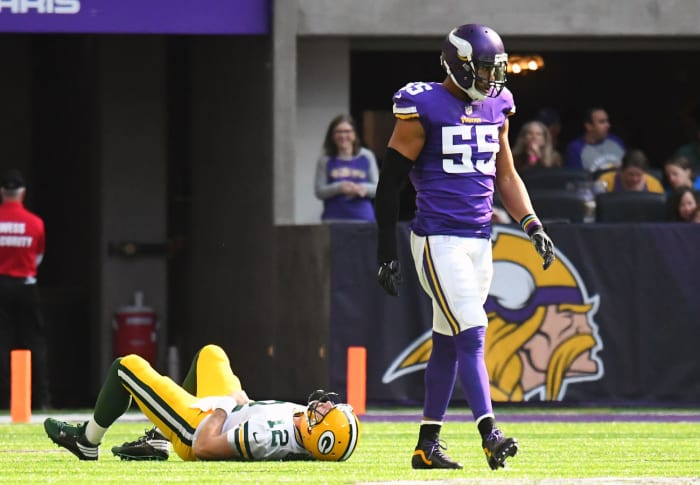
Anthony Barr’s hit on Aaron Rodgers knocked the Packers QB out for the rest of 2017.
Nick Wosika/Icon Sportswire via Getty Images
The reemphasis went largely unnoticed for all of the first 30 minutes of Week 1, until Browns pass rusher Myles Garrett was flagged for a body-weight foul after sacking the Steelers’ Ben Roethlisberger on what appeared to have been a legal tackle, as defined over most of the history of professional football. Garrett kept his head clear, wrapped up Roethlisberger and appeared to roll off the QB as the two fell to the wet grass. That league officials would later say Garrett shouldn’t have been penalized was small consolation for Cleveland—the penalty led to a first down, and then a touchdown, during a game that finished tied at 21.
There would be more. In Week 2, the Packers’ Clay Matthews was flagged for a hit on the Vikings’ Kirk Cousins. Matthews hit Cousins just after the QB released the ball, and while the linebacker did hit him flush in the chest and take him to the ground, Matthews also kept his own head (and Cousins’s) out of the play. He did not fully wrap his arms around the quarterback (taboo, because it pins the passer’s arms, preventing him from breaking his own fall; this is called “burping” the quarterback, a visceral nickname). Matthews even placed his own right arm on the ground to soften the entire collision. For all of this Green Bay was penalized, and what would have been a game-clinching interception on the play was negated. The teams finished tied at 29.
Matthews was livid afterward. “I have so many emotions running through as far as what a terrible call it was,” he said. “You tell me. Did I put pressure on him? I thought I hit him within his waist to chest; I got my head across, put my hands down. . . . I feel like I did the right thing to influence the game. I’m trying to bite my tongue, but I obviously don’t agree with [the call].” (When Matthews came back a week later against the Redskins, bagged Alex Smith with a sack that appeared even more textbook and somehow still got flagged, it seemed to cement the end of football as we’ve known it, judging by the outrage on Twitter.)
Former NFL coach Jeff Fisher, a longtime member of the rules committee, is perplexed by all of this. “That was a textbook example of how to tackle the quarterback—and then everybody in the league office agrees it’s a foul?” he says of the Cousins hit. “That’s the unintended consequence here.
“Or maybe it’s an intended consequence.”
In Week 3, Dolphins defensive end William Hayes paid for all this confusion when he tore his right ACL trying to avoid landing on top of Raiders quarterback Derek Carr during a sack—definitely an unintended consequence. That incident rippled throughout the league. In Cleveland, Garrett told reporters, “I’m not willing to tear something to lay [the quarterback] on the ground like he’s a child.” In Tampa, Buccaneers defensive tackle Gerald McCoy was miked on Monday night against the Steelers when he was caught apologizing as he hit Roethlisberger—“My fault, Ben”—a slice of pocket theater, once unimaginable, that was totally on brand at the moment. Overall the raw numbers are bracing: Through the first four weeks of the regular season there have been 38 roughing the passer calls in 63 games. In 2017 there were 21 in the same number of games.
When Fourth-Down Gambles Pay Off—and When They Don’t: Going For It In Week 4
Across locker rooms, defensive players are wrestling with the further tightening of the rules. “Obviously the coaches are going to tell you, ‘Guys, we’ve got to be smarter,’ but I know they feel like it’s complete b.s., the way we’ve got to tackle quarterbacks now,” says Broncos linebacker Shane Ray. “It’s not going to work like that. You can’t hit quarterbacks low, you can’t hit them high—and then if you hit them in the middle and run your feet, you’ve got to try not to fall on top of them. It’s almost impossible.”
Impossible and, really, impractical. “It’s hard to calculate,” says Bears linebacker Danny Trevathan. “You aren’t really thinking about how much pressure you put on a guy when you tackle him. It’s all about getting him on the ground.”
Giants linebacker B.J. Goodson says, “It’s best just to err on the side of aggression and let the refs be decision-makers.” Or, as Grant Wistrom, a former NFL defensive end who accumulated 53 career sacks from 1998 to 2006, says: “In the NFL, things happen too quickly to make careful judgments. If I was playing now, I’d be inclined to just make the play and take the flag.’’
Full stop here. Most of the rules changes and adaptations over the last decade-plus have been presented as safety initiatives. And they are. Partly. In truth, every league decision in this area runs on three parallel tracks. First, actual player safety. Second, perceived player safety. And third, the business of football. As to the first and second, even the most cynical observer would agree that the changes of the last decade or so have made professional football safer. But also: The NFL has succeeded, in some immeasurable degree, in using “safety initiatives” to placate the head trauma lobby that has a lot of science—and an increasing number of moms—on its side. And that is good for business.
Something else is good for business: Offense. Long passes. Short passes. Yardage. Touchdowns. Offense is very good for business. Shootouts are very good for business.
The body-weight emphasis has endangered a foundational football play: the sack. In the lore of the professional game, raging quarterback-hungry defenders are chilling and integral figures. Not just Deacon Jones, but the Purple People Eaters, the Dallas Doomsday Defense, the Steel Curtain and the New York Sack Exchange. Lawrence Taylor is considered by many the best defensive player in history (and by some, the best player, period) first and foremost because of his game-changing ability to reach the QB on breathtaking rushes from the edge. This new emphasis on preserving QBs endangers all of that in the long- and short-term.
But there is a very strong possibility that the world’s richest sports league is gambling it can survive the loss of sack-centric entertainment because it has, above all, offense. “The NFL is trying to say that this [roughing-the-passer emphasis] is a safety issue, and that that is a noble endeavor,” says Matt Hasselbeck, an NFL quarterback of 17 seasons and now an ESPN analyst. “But it’s really a business issue. You’re seeing defensive players paying the price for the sins of defensive players from 20 years ago, when coaches would teach players how to hurt a quarterback. Pin the arms, take them to the ground. . . . This is how you separate the shoulder, this is how you break the clavicle. . . . But if Cam Newton is not on the field, that’s not good for the league’s bottom line. It’s tough that William Hayes tore his ACL. But the league would rather have Hayes out than have Derek Carr out. That’s just the reality.”
The players see it. “I know we need to keep our quarterbacks healthy. Those guys make football what it is, so we’ve got to take care of those guys,” All-Pro Broncos linebacker Von Miller said in training camp. “But it’s not just one man playing,” adds Browns defensive end Emmanuel Ogbah. “If they want to take care of somebody, take care of everybody.”
Changes have consequences. For more than two decades the NFL has tweaked its rule book in ways that universally benefit the passing game in general and quarterbacks in particular: the 1994 rule that reduced downfield contact with receivers; the 2006 rule prohibiting low hits on the QB; rules (and modifications) in ’10, ’11 and ’12 protecting a defenseless receiver. These and others have tilted the sport away from the ground game—“I’m showing my age because I yearn for the days where first and second downs were an opportunity to run the ball,” says Rivera—and even further away from any defensive advantage.
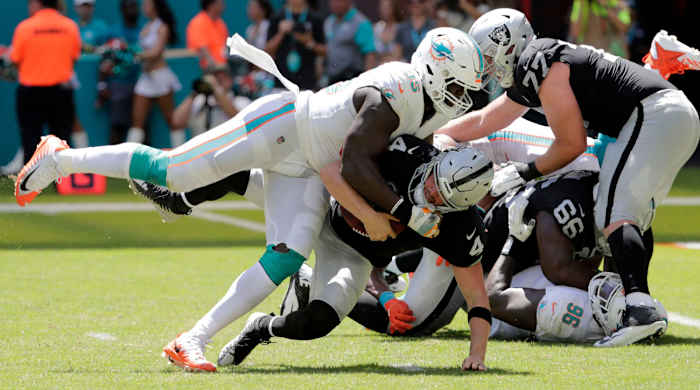
In some observers’ eyes, the Hayes–Carr incident spotlights an unseemly truth: The league would rather lose a relatively faceless defensive lineman than a franchise quarterback.
Lynne Sladky/AP/REX/Shutterstock
The result has been an early season of dizzying aerial success. On Sunday, the apotheosis of the most explosive passing week in NFL history (608.9 yards per game), an unprecedented five quarterbacks passed for more than 400 yards—the same number of passers who accomplished that in the entiredecade of the 1970s. Only once before, in October 2014, had four quarterbacks ever exceeded that mark in a game week. Here’s another ridiculous stat: Through four weeks, five players are completing more than 70% of their passes. A year ago only Drew Brees finished above that mark—and he’s currently sitting at 75.8%, easily his career high. At age 39. Troy Aikman led the league 25 years ago with 69.1%, and only he and Steve Young were above 63.2% that year; today, 24 QBs are above that number. Oh, and you want to hear real silly? Four quarterbacks—Roethlisberger, the Rams’ Jared Goff, Cousins and Carr—are on pace to break Peyton Manning’s single-season passing record of 5,477 yards.
These numbers will surely regress toward the mean, but there’s reason to believe they will not reach it. The NFL has clarified the body-weight rule “to ensure consistency,” but it made no substantive change. Officials will eventually make fewer such calls—after 34 roughing calls in the first three weeks, there were only five this weekend, two of them questionable—but the rule adjustment is already baked into the game.
Are Roughing the Passer Penalties Decreasing? Tracking the Week 4 Quarterback Hits
And offensive players have already adapted. “Already, I’ve seen quarterbacks holding the ball longer,” says former NFL coach Tony Dungy, co-host of NBC’s Football Night in America. “It’s like, Hey, they can’t hit me? I’m going to wait. The same thing happened with defenseless receivers. Once quarterbacks knew defensive backs wouldn’t hit guys in that situation, they started throwing the ball into tighter windows.’’
Hasselbeck concurs, citing personal experience. “We reached a point where you just couldn’t throw the 18-to-21-yard seam route, receivers were just getting hit so hard. So you just stopped throwing that ball. That play didn’t exist. Then the league made the defenseless receiver rule, and that route was back in play again. It’s the same with roughing the passer.”
The football ecosystem is impossibly complex. Its dangers have never been more apparent, yet it remains the most popular spectator sport in America, by a significant margin. Participation numbers are declining everywhere, even as the keepers of the sport at all levels have made changes to try to stop the bleeding. “It’s going to be crazy what [football] is going to look like,” says Giants safety Curtis Riley, in his fourth year. “Five years from now . . . I don’t know.”
No one knows for sure. But we have a good idea because the NFL’s fiscal plan is thinly veiled. Big hits are bad business. Touchdowns and healthy quarterbacks are good business. The eye of the needle grows smaller, and societal pressure to protect the performers while also protecting the bottom line grows more urgent. This is the new football.
Additional reporting by Ben Baskin, Jonathan Jones, Kalyn Kahler, Robert Klemko and Jenny Vrentas.
Question or comment? Email us at talkback@themmqb.com.


































